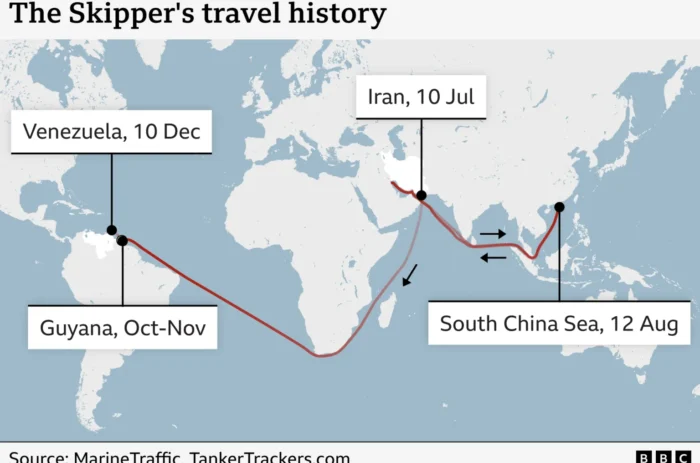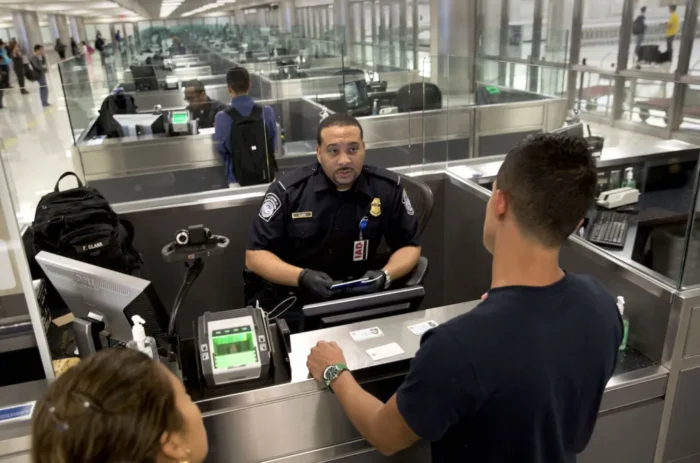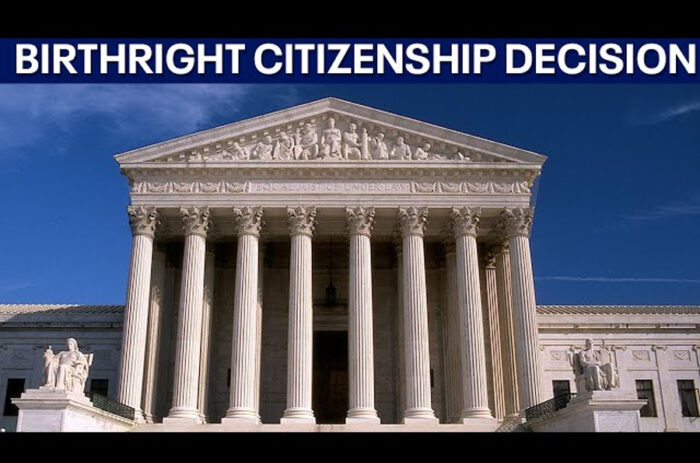redo Jump to...
print Print...
(by Joseph Goldstein, NYSun.com) – The Supreme Court has eliminated President Bush’s main reason for keeping open the detention center at Guantanamo Bay, Cuba, ruling yesterday that prisoners there will be allowed to petition civilian courts in America for their release.
In a 5-4 ruling, the court decided that the constitutional right to habeas corpus applies to noncitizens held at the overseas naval base. The military six years ago began bringing captured men to Guantanamo, instead of to the American mainland, because Bush administration lawyers believed that right did not apply there.
Justice Scalia’s dissent indicated that he believed the result would, one way or another, lead to the release of terrorists. Citing reports that more than 30 men already released from Guantanamo have re-emerged as terrorists or soldiers, Justice Scalia issued a dark prophecy.
“It will almost certainly cause more Americans to be killed,” the justice wrote of the effect he foresees that the majority decision will have.
Congress, when led by a Republican majority, had challenged the Supreme Court over its earlier Guantanamo decisions. But voiding the effect of yesterday’s ruling would require a step that Congress is unlikely to take: a vote to suspend habeas corpus.
Habeas corpus is the authority of judges to order a prisoner brought to court for the purpose of deciding whether the detention is illegal. The fact that habeas corpus does apply to Guantanamo doesn’t necessarily mean that the federal courts will order the release of any detainee in the near future. Yet the prospect of having to go to U.S. District Court to justify the continued incarceration of individual prisoners could prompt the Bush administration to speed up its release of some of the approximately 250 detainees at Guantanamo who have not been charged with war crimes.
“I think what they will try to do is get as many people out of Guantanamo as soon as possible,” an expert in military law, Eugene Fidell, said.
Detainees are now free to file petitions in any district court of their choosing. But Justice Kennedy, who wrote for the majority, said the executive branch could have them shifted over to district court judges in Washington, D.C. It remains to be seen whether the proceedings will happen in D.C., or whether judges will fly to Guantanamo to hold hearings there.
As of yet no rules yet exist to say what form the habeas proceedings will take, how much of the proceedings or court filings will be public, and what the rules of evidence will be. The decision provides no guidance at all on these questions.
“That mere fact that the court clerk’s office is open doesn’t mean that any judge is going to liberate any detainee,” Mr. Fidell, who is of the firm Feldesman Tucker Leifer Fidell LLP, said. “Anyone familiar with the course of habeas doctrine knows this is hard work that rarely produces positive outcomes for the petitioner.”
The purpose of the habeas proceedings will be to decide whether a prisoner should be counted as an “enemy combatant,” in which case he can remain incarcerated.
“Actual cases of mistaken identity are the sum and substance” of who will get released through habeas corpus, a law professor at Pepperdine University, Douglas Kmiec, said. For the government to win the continued incarceration of detainees, “all you have to do is show they were an enemy combatant,” he said.
But the very definition and scope of who counts as an “enemy combatant” will also be contested during the proceedings, legal experts say. While the Supreme Court has held that those Guantanamo detainees who were captured on the battlefield fighting for the enemy certainly count and can be detained by the military, the Supreme Court hasn’t upheld the designation for prisoners there who were apprehended under less clear-cut circumstances.
A major division between the majority and the dissenters involved their characterization of the due process that Guantanamo detainees were currently receiving from the military. Justice Kennedy, who was joined by justices Stevens, Souter, Ginsburg, and Breyer, described the military hearings currently held to determine whether prisoners are “enemy combatants” as having a “considerable risk of error.” The consequence of those errors, Justice Kennedy wrote, could be “the detention of persons for the duration of hostilities that may last a generation or more.”
Chief Justice Roberts, who wrote a dissent joined by justices Alito, Scalia, and Thomas, faulted the majority for so quickly dismissing the military hearings, known as Combat Status Review Tribunals.
“Today the Court strikes down as inadequate the most generous set of procedural protections ever afforded aliens detained by this country as enemy combatants,” Chief Justice Roberts wrote. “The political branches crafted these procedures amidst an ongoing military conflict, after much careful investigation and thorough debate.”
Chief Justice Roberts also questioned whether the majority’s decision should be counted as a win for the detainees.
“The majority merely replaces a review system designed by the people’s representatives with a set of shapeless procedures to be defined by federal courts at some future date,” Chief Justice Roberts wrote.
Speaking from Rome, President Bush said: “We’ll abide by the court’s decision. That doesn’t mean I have to agree with it,”
It is not clear whether district courts will entertain habeas hearings for the 19 detainees held at Guantanamo who have been charged, but not yet tried, for war crimes.
Reprinted here with permission from The New York Sun. Visit the website at NYSun.com.
Questions
1. Habeas corpus is the right to challenge in federal court the legality of one’s detention. In its decision announced yesterday, how did the U.S. Supreme Court rule on the right of habeas corpus for terrorist detainees? (see para. 2, 8-9)
2. What reports did Justice Scalia cite in his dissent? (see para. 3)
3. a) How could Congress void the effect of the high court’s ruling?
b) Do you think that Congress should take this step? Explain your answer.
4. a) List the justices who supported the majority decision.
b) List the justices who dissented.
5. What was a major division between the majority and the dissenters? Be specific.
6. What do you think about the Court’s decision? Be specific.
PLEASE NOTE: “Answers by Email” has ended for the summer.
Background
NOTE ON SUPREME COURT DECISIONS:
It takes a majority of Justices to decide a case. If the Chief Justice sides with the majority, he will write the majority opinion, or assign it to one of the other Justices on the majority side to write. If the Chief Justice is not in the majority, the most senior Justice (the one who has served on the court the longest) writes the opinion or assigns it to another Justice. These opinions are carefully worded since they become the basis upon which similar future cases are argued. Justices on the minority side are free to write dissenting, or differing, opinions. (from bensguide.gpo.gov/9-12/government/national/scourt3.html)
Resources
Read Boumediene v. Bush at scotusblog.com/wp/wp-content/uploads/2008/06/06-1195.pdf.
Read a related article on Boumediene v. Bush at studentnewsdaily.com/news-issue/trial-of-the-century.
Read a commentary on the Supreme Court’s decision here.
Daily “Answers” emails are provided for Daily News Articles, Tuesday’s World Events and Friday’s News Quiz.



